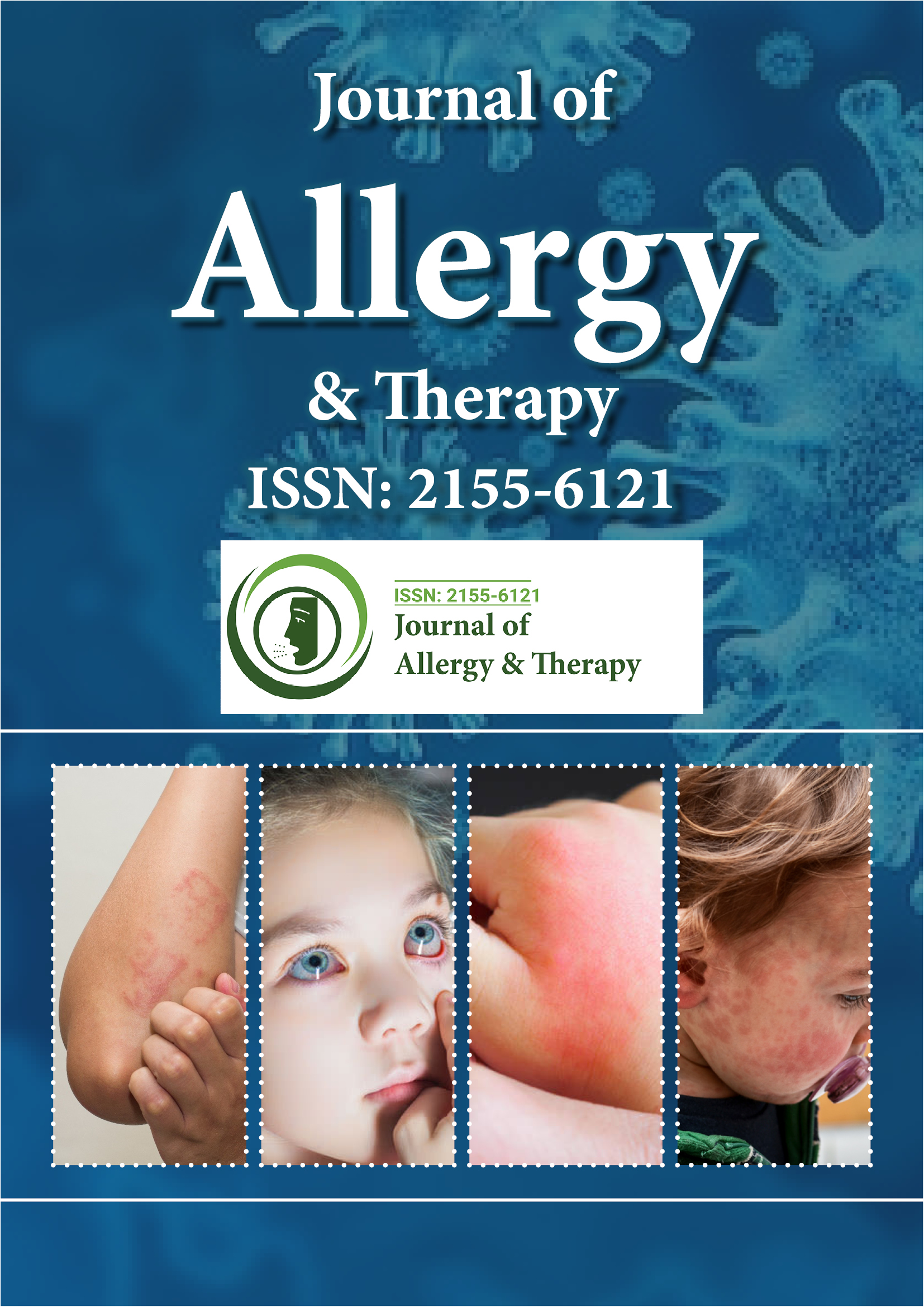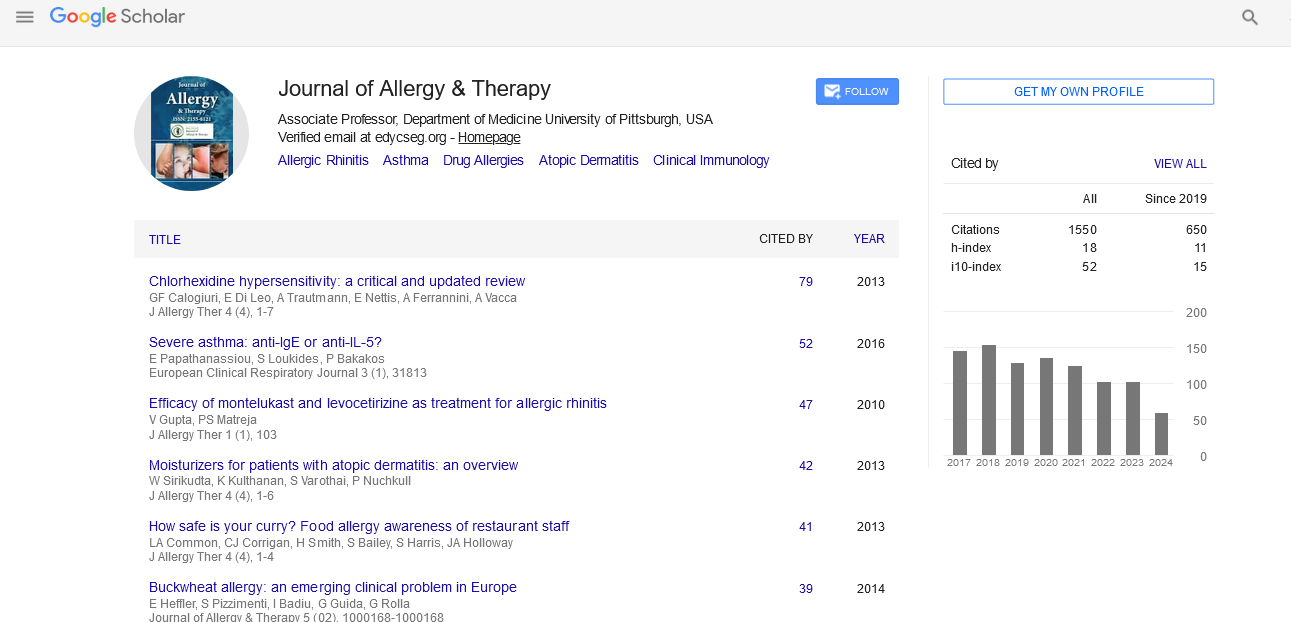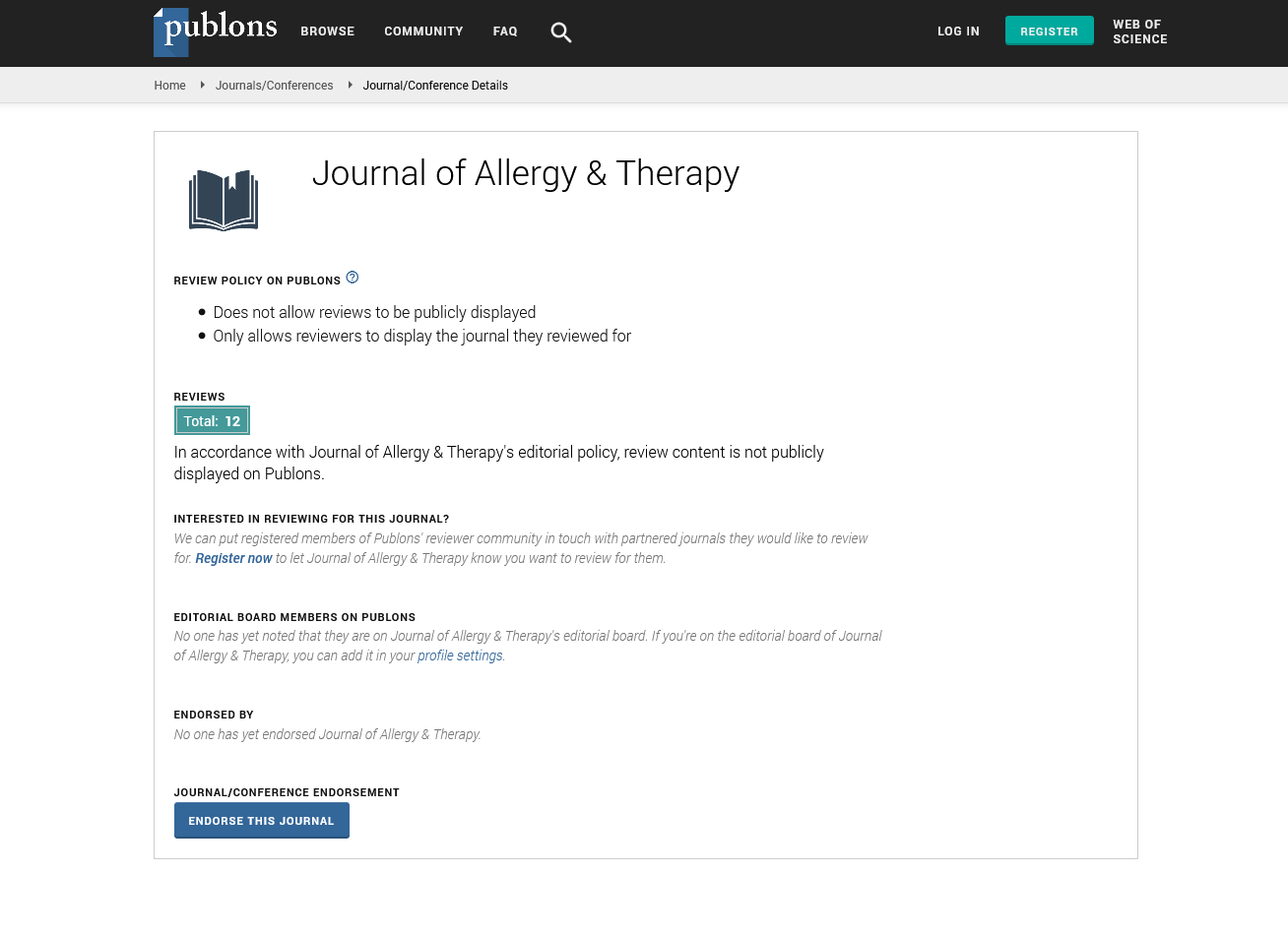Indexed In
- Academic Journals Database
- Open J Gate
- Genamics JournalSeek
- Academic Keys
- JournalTOCs
- China National Knowledge Infrastructure (CNKI)
- Ulrich's Periodicals Directory
- Electronic Journals Library
- RefSeek
- Hamdard University
- EBSCO A-Z
- OCLC- WorldCat
- SWB online catalog
- Virtual Library of Biology (vifabio)
- Publons
- Geneva Foundation for Medical Education and Research
- Euro Pub
- Google Scholar
Useful Links
Share This Page
Journal Flyer

Open Access Journals
- Agri and Aquaculture
- Biochemistry
- Bioinformatics & Systems Biology
- Business & Management
- Chemistry
- Clinical Sciences
- Engineering
- Food & Nutrition
- General Science
- Genetics & Molecular Biology
- Immunology & Microbiology
- Medical Sciences
- Neuroscience & Psychology
- Nursing & Health Care
- Pharmaceutical Sciences
Short Communication - (2024) Volume 15, Issue 4
Novel Biomarkers for Early Detection of Food Allergen Sensitization in Pediatric Populations
Hiroshi Ohta*Received: 29-Nov-2024, Manuscript No. JAT-24-28022; Editor assigned: 02-Dec-2024, Pre QC No. JAT-24-28022 (PQ); Reviewed: 16-Dec-2024, QC No. JAT-24-28022; Revised: 23-Dec-2024, Manuscript No. JAT-24-28022 (R); Published: 30-Dec-2024, DOI: 10.35248/2155-6121.24.15.407
Description
Food allergy diagnosis and prevention has entered a new era with the emergence of advanced biomarker detection methods. The rising prevalence of food allergies among children, now affecting approximately 8% of pediatric populations in developed nations, has sparked intensive research into early detection mechanisms [1]. Traditional diagnostic approaches, while valuable, often identify allergies only after clinical manifestation, potentially missing important windows for intervention and prevention. Biomarkers, serving as biological indicators, can reveal immunological changes before the onset of clinical symptoms. These markers include a diverse array of measurable substances, from specific antibodies and cytokines to microRNAs and other molecular signatures [2].
The advancement in molecular biology and immunology has significantly expanded our understanding of these early indicators, particularly in identifying children at risk for developing food allergies [3]. Recent research has identified several potential biomarker categories. Specific IgE patterns, traditionally used in allergy diagnosis, are re-evaluated for their predictive potential when measured in combination with other markers. Basophil activation markers have shown particular potential in predicting reaction severity. Cytokine profiles, especially those involving IL-4, IL-13 and IL-33, provide insights into the immunological processes underlying sensitization. One of the most exciting developments involves microRNA profiles [4,5].
These small, non-coding RNA molecules play significant roles in gene expression regulation and immune response modulation. Studies have identified specific microRNA signatures appearing months before clinical manifestation of common food allergies. For example, elevated levels of miR-193a-5p and miR-223-3p have consistently observed in children who later develop peanut and egg allergies [6]. The implications of reliable biomarker identification extend far beyond diagnosis. Early risk identification enables targeted interventions, including modified feeding practices and monitored exposure protocols. This approach aligns with personalized medicine principles, allowing customized prevention strategies based on individual risk profiles. Furthermore, biomarker monitoring during treatment can help assess intervention effectiveness and guide therapeutic modifications [7].
Understanding the genetic and environmental factors influencing biomarker expression has become essential. Family history, environmental exposures and dietary patterns all affect how these biological indicators manifest. This complex interplay necessitates a comprehensive approach to biomarker interpretation, considering multiple factors rather than relying on single measurements. Clinical implementation of biomarker testing faces several challenges. Standardization of testing methods, cost considerations and the need for large-scale validation studies represent significant hurdles. Additionally, the dynamic nature of immune system development in children requires careful consideration of age-related variations in biomarker expression [8].
Looking ahead, the field of biomarker research continues to evolve rapidly. Emerging technologies, including proteomics and metabolomics, provide new possibilities for identifying additional markers. The integration of artificial intelligence and machine learning algorithms may enhance our ability to interpret complex biomarker patterns and predict allergy development more accurately. For healthcare providers, understanding these advances in biomarker research is essential for optimal patient care. The ability to identify at-risk children before symptom onset could revolutionize food allergy prevention strategies [9,10]. This knowledge enables proactive rather than reactive approaches to allergy management, potentially reducing the incidence of severe allergic reactions.
Patient education about biomarker testing becomes increasingly important as these technologies become more available. Families need to understand both the capabilities and limitations of these tests, as well as their role in comprehensive allergy management strategies. Clear communication about what biomarker results mean and how they influence treatment decisions is essential for effective patient care. The economic implications of early biomarker detection are significant.
In conclusion, initial testing costs may be substantial, early intervention could reduce long-term healthcare expenses associated with managing established food allergies. This costbenefit analysis becomes particularly relevant when considering population-wide screening programs. Research priorities moving forward include identifying new biomarkers, validating existing ones across diverse populations and developing more costeffective testing methods. The goal is to create comprehensive, accessible screening protocols that can be implemented in various clinical settings, from specialized allergy centers to primary care practices.
References
- Barni S, Liccioli G, Sarti L, Giovannini M, Novembre E, Mori F. Immunoglobulin E (IgE)-mediated food allergy in children: Epidemiology, pathogenesis, diagnosis, prevention, and management. Medicina. 2020;56(3):111.
[Crossref] [Google Scholar] [PubMed]
- Zhang L, Zhang L, Chen H, Xu X. The Interplay between cytokines and MicroRNAs to regulate metabolic disorders. J Interferon Cytokine Res. 2024;44(8):337-348.
[Crossref] [Google Scholar] [PubMed]
- Yu W, Freeland DM, Nadeau KC. Food allergy: Immune mechanisms, diagnosis and immunotherapy. Nat Rev Immunol. 2016;16(12):751-65.
[Crossref] [Google Scholar] [PubMed]
- Sun B, Zhu L, Tao Y, Sun HX, Li Y, Wang P, et al. Characterization and allergic role of IL-33-induced neutrophil polarization. Cell Mol Immunol. 2018;15(8):782-793.
[Crossref] [Google Scholar] [PubMed]
- Leaker BR, Malkov VA, Mogg R, Ruddy MK, Nicholson GC, Tan AJ, et al. The nasal mucosal late allergic reaction to grass pollen involves type 2 inflammation (IL-5 and IL-13), the inflammasome (IL-1β), and complement. Mucosal Immunol. 2017;10(2):408-420.
[Crossref] [Google Scholar] [PubMed]
- Wood RA, Togias A, Sicherer SH, Shreffler WG, Kim EH, Jones SM, et al. Omalizumab for the treatment of multiple food allergies. N Engl J Med. 2024;390(10):889-899.
[Crossref] [Google Scholar] [PubMed]
- Parolo C, Idili A, Ortega G, Csordas A, Hsu A, Arroyo-Currás N, et al. Real-time monitoring of a protein biomarker. ACS Sens. 2020;5(7):1877-1881.
[Crossref] [Google Scholar] [PubMed]
- Nazari L, Zinati Z. Gene expression classification for biomarker identification in maize subjected to various biotic stresses. IEEE/ACM Trans Comput Biol Bioinform. 2023;20(3):2170-2176.
[Crossref] [Google Scholar] [PubMed]
- Sicherer SH, Sampson HA. Food allergy: A review and update on epidemiology, pathogenesis, diagnosis, prevention, and management. J Allergy Clin Immunol. 2018;141(1):41-58.
[Crossref] [Google Scholar] [PubMed]
- Heine RG. Food allergy prevention and treatment by targeted nutrition. Ann Nutr Metab. 2018:72(S3):33-45.
[Crossref] [Google Scholar] [PubMed]
Citation: Ohta H (2024). Novel Biomarkers for Early Detection of Food Allergen Sensitization in Pediatric Populations. J Allergy Ther. 15:407.
Copyright: © 2024 Ohta H. This is an open access article distributed under the terms of the Creative Commons Attribution License, which permits unrestricted use, distribution, and reproduction in any medium, provided the original author and source are credited.


